 |
||
|
||
| ||
We haven't tested yet products from the Chinese company Legend. However, now with the release of new chipsets for the modernized Pentium 4, the wave of QDI's products has already reached our lab. Soon you will see test results of several mainboards of this company, and now I'd like to share some interesting facts concerning products of Legend QDI on the whole, and show you a brief photo-report on the production pool of the company in the Chinese city of Huiyang and, in particular, on a mainboard production line. General factsAs to its name, Legend is the general name of a multifield concern which deals with production of PCs, various components (including mainboards, network and video cards etc.), provides Internet access etc. QDI is a trade mark of this company which produces mainboards as well. For this subdivision, the products of which are of the most interest for us, we could equally use Legend QDI or just QDI names. I'm not an expert in finished solutions, that is why without knowledge on the local market I can't give you detailed information on such fields the company works in as production of computers (especially without testing them) or portable devices. I will just show you a couple of photos of nice models, and I must say that Legend has been being a leader for several years already in the PC sales volumes in the Asian-Pacific region and goes into the top 20 (according to IDC).   A wide range of products, introduction of various innovations (for example, user identification according to a finger print on a keyboard receiver), flexibility of offered solutions allows the company get orders from multiple (you know, this is China) public and government offices. A great stress is laid on OEM collaboration; a lot of world-wide brands (such as HP or IBM) place orders for finished solutions or components with Legend. Its own production capacities allow the company to modify or produce special versions of mainboards by request, using unique local components as well. Legend possesses a huge research center the experts of which work intimately in contact with members of the Chinese Academy of Sciences. Beside such labs which deal with electromagnetic radiation or structural analysis of materials the Center has an audio lab with an anechoic room for acoustic listening. Of course, there is a department which controls software of multiple innovative technologies; and the company is very proud of it. Now I'd like to turn to them.  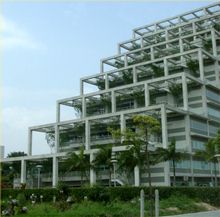 Innovations of the companyInnovations are the special pride of Legend QDI and the advantage the company stakes on to take the leading positions on the world market. Let's take a look at the most interesting ones.  SpeedEasy II. The first version of the SpeedEasy technology of jumperless system overclocking was first introduced by this company yet in 1996. The technology was patented, and now we already have the second version. A special menu of the BIOS Setup allows you to choose a processor speed (among offered values) and change voltage supplied to processor, memory and video card (the processor voltage can be both increased and decreased). At present, all big mobo makers produce models with such functionality; the most famous similar technology was developed by Abit - SoftMenu (several versions). If parameters set are too high (the system can't boot) it's possible to bring back the default settings and then continue changing parameters anew.  StepEasy II. A logical extension of the technology of overclocking from BIOS is a program which can do the same from Windows, with a user-friendly graphics interface. The screenshot clarifies the principles of its operation. 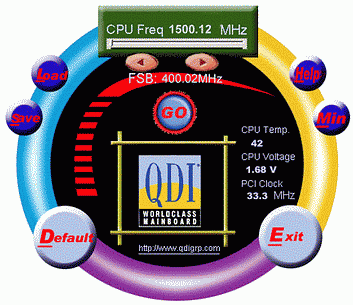 Just remember that the technology can't change voltage of components, you must do it manually using the SpeedEasy II technology. It also displays temperature and voltage of the processor which makes possible to trace the system state in the real time mode. The overclocking technologies come with two protective features of the QDI's boards. The first one is typical of modern Pentium 4 based boards and offers three levels of reaction to the CPU temperature growth: sound alert, slowdown and, finally, shut-down of the processor. The second one (Hardware Doctor) has some "twins" of other firms 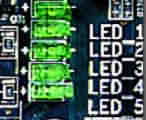 and uses LEDs' signals during implementation of the POST procedure. The LEDs which go up in turn, register initialization of processor and chipset (1), memory (2), PCI peripherals (3), clock generator (4) and video card (5).  RecoveryEasy II. This data backup and recovery technology is much rarer, though it is not unique either (there is, for example, HDD Instant Recovery used on some boards from Chaintech). The idea is that during the system booting it's possible to enter the BIOS Setup to save the HDD partition table or even whole partitions into a hidden area on the same hard drive - in this case the Host Protected Area technology is used. (It is also possible to save current CMOS settings.) Later, in case of data losses or misoperation of an OS (because of a virus or deletion of some system files) you can recover the information, while none but the program written into the BIOS can access the hidden area. Of course, if the hard drive breaks, nothing can help here (the current version of the technology can't reserve data of one physical disc in another, like the RAID), but it is still useful to have it at hand, especially if you like experiments with OSes. Note that the RecoveryEasy II is quite smart: it uses only that size of the disc for data backup which is required by those data; secondly, it allocates space for data storage by request without preliminary disc partitioning and saving half of its size for the future backup area. The latter two peculiarities make this QDI's technology unique among similar solutions.  LogoEasy II. The technology of creating your own logo to be displayed during booting is not very important for operation of the system, but taking into account that all majors do have something similar (ASUS MyLogo or Gigabyte Face-Wizard), QDI couldn't remain aside. The second version of this technology allows displaying images of up to 16M colors up to 800x600 inclusive. The image can be spread onto the whole screen or put into a corner so that you can see the system booting information. And all this is just for the sake of 2-3 seconds of the POST procedure and initialization of devices! Once you decide to use it, you have almost nothing to do - after booting the OS (the LogoEasy II works under any Microsoft OS - from DOS to Windows XP) you should run the respective application and choose a graphics file (BMP or JPEG) and parameters of the future image (preview is certainly supported). Then you can place the chosen image into the flash BIOS file or implement reprogramming directly in the Windows.  BootEasy. This quick start technology is also rather entertaining than crucial for system. The idea is simple: during the first startup of the computer after activation of the technology (in the BIOS Setup) the system state is saved (the number of memory chips on the processor, configuration of the peripherals etc.), and next time instead of the usual sequential initialization of all devices it addresses the final system state saved in the flash memory. Thus, every time you can save some time. However, the reality is a bit different. First of all, this doesn't work with external devices which have their own flash memory and require normal initialization (for example, external IDE RAID or SCSI controllers). Secondly, although it's possible to save up to 40 seconds according to QDI (making it as short as 3-5 sec.), only about 5 sec. in reality can be saved, because I have never seen a modern computer with a more or less complicated set of components where the start procedure would be longer than 10 sec. (from starting up to transfer of control to the loader on the booting device). Besides, when the configuration changes (for example, an expansion card is added) it's necessary to update it (disable the BootEasy before changes and then turn on again after them). But there will be no problems if you don't do it: in case of data failure of the BootEasy in the flash memory or unsuccessful startup of the computer the data will be brought to their default values, and devices will go through normal checkup and initialization (new data will be automatically saved after that). In closing I'd like to show you three more factors which cross out the advantages of the technology. The first inconvenience is that you have to press and hold the Delete button (if you try to enter the BIOS Setup) yet before rebooting (start-up) of the system because it will be quite difficult to catch the exact moment. Secondly, having pressed the power button, you look at the monitor and... see nothing on it for some time (this is quite a tough torture for your heart especially if the hard drive works noiselessly... At last: the activated BootEasy doesn't allow for any pictures which you must have prepared with the LogoEasy II! ;) QDI possesses some more technologies with luxurious names (all are Easy) and functions typical of solutions of other manufacturers. The technologies listed above and their continuous improvement make us respect Legend QDI; the overall quality and stability of the boards further the growth of quantity of the boards on the market: according to the Taiwanese site Digitimes, QDI takes the 5th place in 2001 in the number of sold boards after ECS, ASUS, MSI and Gigabyte (though the gap is huge) and the first place in China. Production pool in HuiyangAlthough victory is forged in headquarters, it is won on battlefields, that is why let's leave the office in Shenzhen and go to the production departments in Huiyang. The pool measuring 800,000 m2  is just partly developed: the built-up area spreads only to the river. Here we have the Legend PC assembly shop, a mainboard production shop, 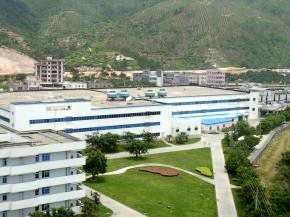 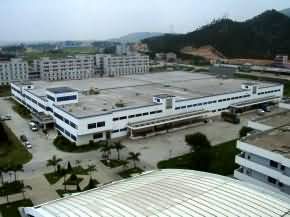 living quarters for the employees, 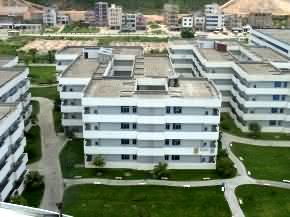 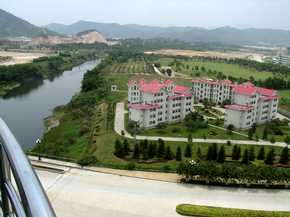 and a dining-room with a great number of fans.  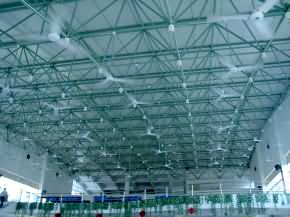 The developed area includes a bridge which, at present, leads to nowhere.   By the way, the river is constantly purified, and fish have nothing to afraid of.  I'm not going to describe the order of the finished PC assemblage and just offer you some photos: 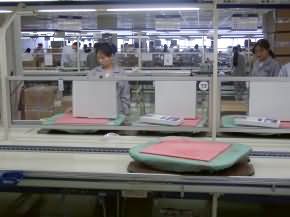    Production line - assemblage  Photos of workers of the current shift  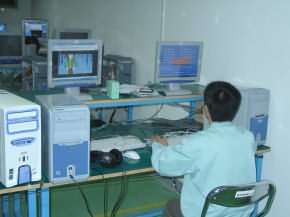 Service and software testing departments   Box packaging and storage What I'd like to dwell on is functioning of the mainboard assembly line. Before entering the room with a production line everyone takes has an electrical safety test (the journalists who swore to touch nothing had only antistatic shoe covers).  The line (there are four of them, with the total output up to 500,000 products a month) starts with processing of "newly-baked" printed-circuit boards. The PCB production lines (the latest technologies and equipment allow printing boards of up to 18 layers) weren't captured.  The pack of the boards is put into a device which covers them with special paste (for further soldering of components). 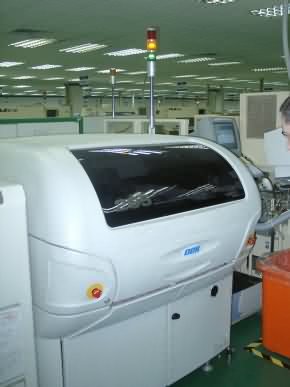 After that each board goes to the production line to be scanned: the general information system of the company receives data on the series number which are further used to trace quality, get statistics etc. 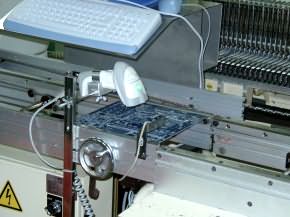 The today's QDI's pride is a completely automated device for surface mounting of components (the special paste was used exactly for such components). 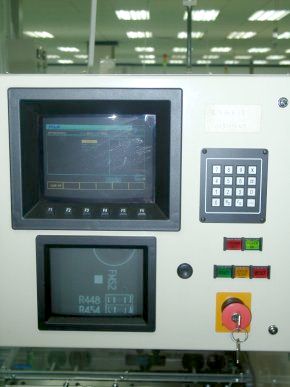 Inside this machine is a mounting device which is shown on the following shot. In action it looks like a sextuple heavy machine-gun (and maybe even more tremendous as far as the noise level is concerned). 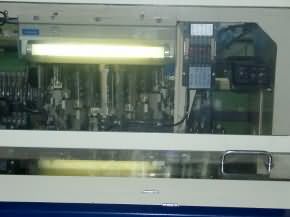 The hammered-in components (at this stage only basic elements are mounted: processor socket, chipset dies, resistors etc.) make the board look like what we got used to see, and then comes the first stage of visual examination.  Two girls, working simultaneously, put a template on each board brought by the line and check whether all necessary elements are mounted. 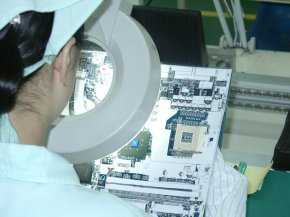 If the result is positive (the opposite is almost incredible) other elements are mounted manually - DIMMs, PCI, a rear panel unit, capacitors etc. 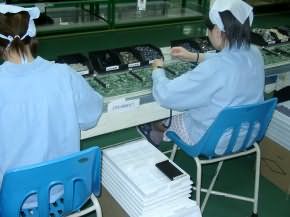 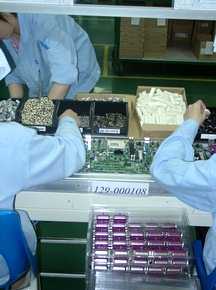 After that the boards go into an oven for proper soldering. 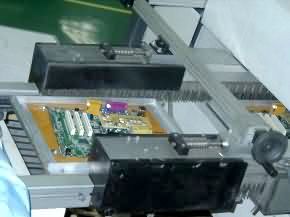  This is the end of the production; the next stage is conveyer testing. First come simple tests: visual test of soldering quality, components, basic electrical tests (for short circuit and lack of contacts).  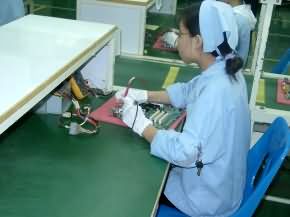 It is followed by the complex testing of functionality using special test cards.   In case of some errors the workers stick a special ticket to such board, 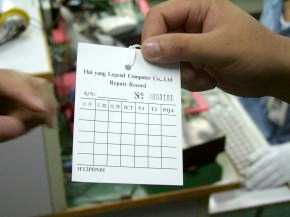 and its life will end at the end of the line.  The boards that passed all the tests are packed  and put into boxes depending on a lot (OEM or Retail).  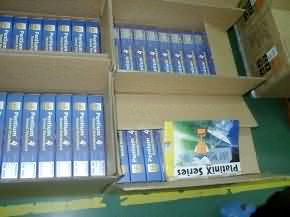 This is how the whole line looks like; about 20 workers (generally, women) work here almost twenty-hours a day (in three shifts).  It should be noted that after the tests each board that failed is closely studied in the diagnostics and repair department to find out whether the problems are occasional or caused by errors in the technological process. If necessary, the respective corrections or changes are made (which, fortunately, happens quite seldom, mostly with new models). Secondly, randomly selected samples of each lot take a special test. QDI pays special attention to it: almost 100% of boards of a new series are tested completely, for others (not new) the figure is 5%. The first mass special test examines functionality after strong heat-up. A lot of boards are put into a chamber where they are heated up to 100°C at a very high moisture level. After this sauna all samples are tested repeatedly on the stand.  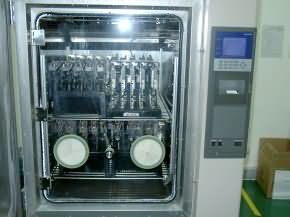 This girl runs the good old 3DMark to test operability of the QDI products in low-temperature conditions.   The following devices which look like torture instruments are used exactly for this purpose. The farthest one is used for the vibration-proof examination, the closest one tests strength (a board falls down which imitates a situation when a user drops it on a floor). 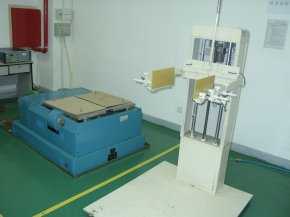 In case of any errors the engineers of the test lab settle required changes for the technological process and make a decision on a necessity to increase the number of boards tested this way and a degree of importance of the problems for a customer. It's pleasant that boards for the OEM lots are produced on the same lines. According to the company, development and application of a unique design for an OEM partner takes only 28 hours before boards are delivered to the stock (for an order of 5,000 samples), that is why it is no surprise that the positions of Legend QDI are so strong in this area. In closing, I'd like to express my gratitude to the European department
of Legend QDI for its help in organization
of visiting their office and production pool.
Write a comment below. No registration needed!
|
Platform · Video · Multimedia · Mobile · Other || About us & Privacy policy · Twitter · Facebook Copyright © Byrds Research & Publishing, Ltd., 1997–2011. All rights reserved. |